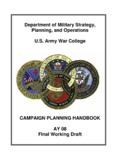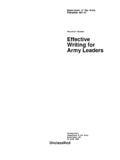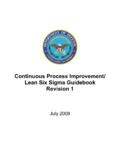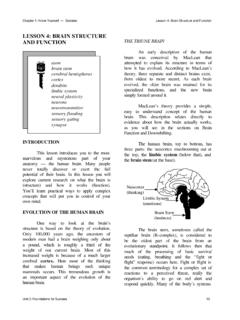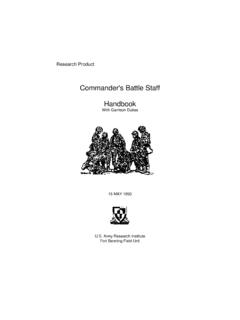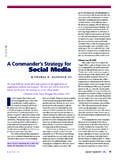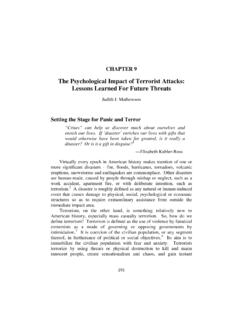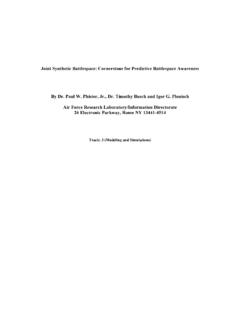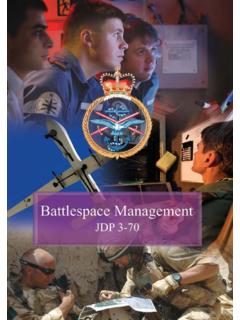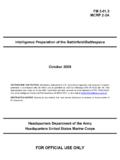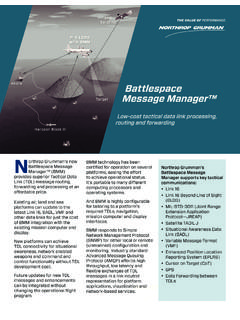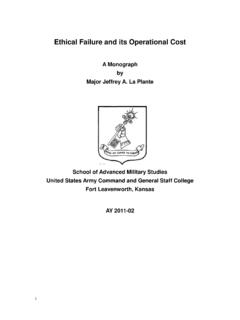Transcription of Insights on Joint Operations: The Art and Science Best ...
1 Insights on Joint operations : The Art and Science Best Practices The Move toward Coherently Integrated Joint , Interagency, and Multinational operations GEN (Ret) Gary Luck Senior Mentor Joint Warfighting Center Joint Forces Command September 2006 Introduction The Joint Warfighting Center s deployable training team is afforded the unique opportunity to visit and support commanders and staffs of Joint headquarters worldwide as they prepare for, plan, and conduct operations . We gain Insights into their challenges and their derived solutions as they support our national interests. The team also has the chance to analyze and compare practices amongst the different headquarters, reflect on the various challenges, techniques and procedures, and draw out and refine what we term best practices.
2 This paper presents a compilation of our Insights and best practices. It provides our observations on the increasingly complex security environment, the resultant evolution of planning and execution of Joint , interagency, and multinational operations , and best practices by commanders and staffs at Joint force headquarters. We lay out the commonly viewed observation on the need for a more holistic view of the environment expanding beyond a traditional military battlefield view to one far more complex with many non-military players. We see this environment as an interconnected system of systems (including political, military, economic, social, informational, and infrastructure) comprised of friends, adversaries, and the unaligned.
3 The paper describes how various Joint headquarters visualize this complex, system of systems environment and use effects-based thinking to complement their operational planning processes. We describe how they are able to inclusively work with the many stakeholders, both interagency and multinational, to harmonize and synchronize military actions with the actions of other instruments of national and international power. This is the essence of operational art. One overarching best practice is the continuing importance of commander-centric operations in which the commander relies on his intuition and judgment, issuing mission-type orders to achieve desired effects.
4 This remains essential, even in this age in which the improvements in technology tempt one to centrally control operations . The team has also culled out many best practices in how Joint headquarters plan, direct, monitor, and assess operations their decision cycles. Recognition that we cannot precisely model the behavior of the complex environment makes assessment an essential part of these decision cycles. We discuss assessment in detail it s an important best practice whose need is reinforced time and again in operational headquarters. We live in a dynamic period. Insights and best practices are continually evolving.
5 We hope to continue capturing and sharing these evolving thoughts and best practices in subsequent Insights papers. Contents 1) Executive Summary .. 1 2) Understanding the 4 a) Today s complex environment b) Visualization of the environment using a PMESII construct c) Catalysts for change in planning and execution of operations 3) Unified Action .. 10 a) Need for Unified Action b) The Stakeholders c) Effects based thinking 4) Commander-centric 12 a) Value of commanders experience and intuition b) Providing guidance and intent c) Importance of personal relationships & trust and confidence 5) Operational Design - Setting Conditions for 13 a) Gaining agility and flexibility b) Interdependence c) Task organization and battlespace geometry d) Command relationships e) Mission approval levels 6) Decision 20 a) The Assess, Plan, Direct, Monitor cycle b) Event horizons c)
6 Interaction with higher, adjacent, and subordinate hqs d) Inclusion with stakeholders e) Elements of the decision cycle 7) JTF Headquarters 26 a) Organization b) Battle rhythm 8) The Military Element of Strategic 31 a) Military support to strategic communication b) Development of a communication strategy c) Action agents available to promulgate the commander s message d) Staff role in developing and executing communication strategy 9) Intelligence Support .. 33 a) Expanding perception from a mil-centric to a PMESII viewpoint b) Adapting intelligence to maintain relevance with today s operations c) Need for decentralization & its organizational Implications d) Data storage challenges to rapid intelligence support 10) Legal Considerations & Rules of 35 11) 36 12) Information Management.
7 37 Intentionally Blank 11. Executive Summary Our military has significantly evolved over the past 5 years as we have adapted to an increasingly complex environment defined by the Global War on Terrorism (GWOT) and other security challenges. Complex environment: Globalization, the information revolution, non-traditional adversaries, and our changing military capabilities have significantly changed today s security environment. It has changed from that of the traditional cold war battlefield to today s dramatically different and more complex battlespace . Unified action: Commanders have experienced the absolute need (and challenges) of unified action - working inclusively with all the stakeholders, both and international, to understand and visualize this complex environment, and synchronize actions to achieve strategic objectives.
8 This need for inclusiveness and interdependence is possibly the most significant adaptation we must achieve to reach ultimate success. Commander-centricity: Observations clearly reinforce the absolute importance of commander s guidance and intent, applying his instinct and intuition in exercising command -- the Art of War . We see commanders not being lured into a control-centric Science of War style despite the technological and informational improvements in today s C4I systems. In fact the most successful commanders build a cohesive command, are good shepherds of their staff (giving guidance and working with them), use mission type orders, and decentralize to the point of being uncomfortable to empower their subordinates.
9 A. The complex environment and catalysts for change: The United States and its allies are engaged in a protracted global war within a very complex security environment. Our enemies are not only foreign states, but also non-state entities, loosely organized networks with no discernible hierarchical structure. These adversaries can not be defined only in terms of their military capabilities. Rather, they must be defined, visualized, and attacked more comprehensively, in terms of their interconnected political, military, economic, social, informational, and infrastructure systems. Four major catalysts for change: globalization; the information revolution; the changing adversaries; and a smaller, more technologically enabled, military force have contributed to the complexity of this environment and fundamentally changed the way the military fights today s global war.
10 Globalization, the world s open economic system of independent global markets, global communication systems, and ubiquitous media presence have all broadened security responsibilities beyond solely a military concern. The information revolution has allowed unprecedented sharing of information both for us and for our adversaries. The realization by our adversaries that winning a conventional mil-on-mil fight is not possible, has led them to expand conflict into domains not previously considered within the realm of traditional military operations during the cold war s conventional battlefield era.
